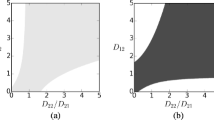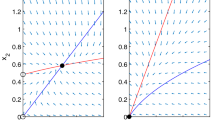Abstract
Competition between species is ubiquitous in nature and therefore widely studied in ecology through experiment and theory. One of the central questions is under which conditions a (rare) invader can establish itself in a landscape dominated by a resident species at carrying capacity. Applying the same question with the roles of the invader and resident reversed leads to the principle that “mutual invasibility implies coexistence.” A related but different question is how fast a locally introduced invader spreads into a landscape (with or without competing resident), provided it can invade. We explore some aspects of these questions in a deterministic, spatially explicit model for two competing species with discrete non-overlapping generations in a patchy periodic environment. We obtain threshold values for fragmentation levels and dispersal distances that allow for mutual invasion and coexistence even if the non-spatial competition model predicts competitive exclusion. We obtain exact results when dispersal is governed by a Laplace kernel. Using the average dispersal success, we develop a mathematical framework to obtain approximate results that are independent of the exact dispersal patterns, and we show numerically that these approximations are very accurate.
Similar content being viewed by others
References
Berestycki, H., Hamel, F., Roques, L., 2005. Analysis of the periodically fragmented environment model. I. Species persistence. J. Math. Biol. 51, 75–113.
Bolker, B., Pacala, S., 1999. Spatial moment equations for plant competition: Understanding the advantages of local dispersal. Am. Nat. 153(6), 575–602.
Botsford, L.W., Hastings, A., Gaines, S.D., 2001. Dependence of sustainability on the configuration of marine reserves and larval dispersal distance. Ecol. Lett. 4, 144–150.
Chesson, P., 2000. General theory of competitive coexistence in spatially-varying environments. Theor. Popul. Biol. 58, 211–237.
Cruywagen, G., Kareiva, P., Lewis, M., Murray, J., 1996. Competition in a spatially heterogeneous environment: Modelling the risk of spread of a genetically engineered population. Theor. Popul. Biol. 49(1), 1–38.
Dewhirst, S., Lutscher, F., 2009. Dispersal in heterogeneous habitats: Thresholds, spatial scales and approximate rates of spread. Ecology 90(5), 1338–1345.
Fagan, W., Lutscher, F., 2006. The average dispersal success approximation: A bridge linking home range size, natal dispersal, and metapopulation dynamics to critical patch size and reserve design. Ecol. Appl. 16(2), 820–828.
Fisher, R., 1937. The advance of advantageous genes. Ann. Eugen. 7, 355–369.
Gurnell, J., Wauters, L.A., Lurz, P.W.W., Tosi, G., 2004. Alien species and interspecific competition: Effects of introduced eastern grey squirrels on red squirrel population dynamics. J. Anim. Ecol. 73, 26–35.
Hart, D., Gardner, R., 1997. A spatial model for the spread of invading organisms subject to competition. J. Math. Biol. 35, 935–948.
Hastings, A., Cuddington, K., Davies, K., Dugaw, C., Elmendorf, A., Freestone, A., Harrison, S., Holland, M., Lambrinos, J., Malvadkar, U., Melbourne, B., Moore, K., Taylor, C., Thomson, D., 2005. The spatial spread of invasions: New developments in theory and evidence. Ecol. Lett. 8, 91–101.
Hosono, Y., 1998. The minimal speed of traveling fronts for a diffusive Lotka–Volterra competition model. Bull. Math. Biol. 60, 435–458.
Kawasaki, K., Shigesada, N., 2007. An integrodifference model for biological invasions in a periodically fragmented environment. Jpn. J. Ind. Appl. Math. 24, 3–15.
Kinezaki, N., Kawasaki, K., Takasu, F., Shigesada, N., 2003. Modeling biological invasions into periodically fragmented environments. Theor. Popul. Biol. 64, 291–302.
Kot, M., 2001. Elements of Mathematical Ecology,. Cambridge Univ. Press, Cambridge.
Levin, S., Culver, D., 1971. Regional coexistence of species and competition between rare species. Proc. Natl. Acad. Sci. USA 6, 1246–1248.
Lewis, M., Li, B., Weinberger, H.F., 2002. Spreading speed and linear determinacy for two-species competition models. J. Math. Biol. 45, 219–233.
Lutscher, F., 2008. Density-dependent dispersal in integrodifference equations. J. Math. Biol. 56(4), 499–524.
Lutscher, F., Lewis, M.A., 2004. Spatially-explicit matrix models. A mathematical analysis of stage-structured integrodifference equations. J. Math. Biol. 48, 293–324.
Lutscher, F., Lewis, M., McCauley, E., 2006. The effects of heterogeneity on population persistence and invasion in rivers. Bull. Math. Biol. 68(8), 2129–2160.
Murrell, D., Law, R., 2003. Heteromyopia and the spatial coexistence of similar competitors. Ecol. Lett. 6, 48–59.
Neubert, M.G., Caswell, H., 2000. Demography and dispersal: Calculation and sensitivity analysis of invasion speeds for structured populations. Ecology 81(6), 1613–1628.
Neubert, M., Kot, M., Lewis, M.A., 1995. Dispersal and pattern formation in a discrete-time predator–prey model. Theor. Popul. Biol. 48(1), 7–43.
Okubo, A., Maini, P., Williamson, M., Murray, J., 1989. On the spatial spread of the grey squirrel in Britain. Proc. R. Soc. Lond. B 238, 113–125.
Pacala, S., Roughgarden, J., 1982. Spatial heterogeneity and interspecific competition. Theor. Popul. Biol. 21, 92–113.
Robbins, T., 2004. Seed dispersal and biological invasion: A mathematical analysis. Ph.D. thesis, University of Utah.
Robbins, T.C., Lewis, M.A., 2006. Modeling population spread in heterogeneous environments using integrodifference equations. Preprint.
Shigesada, N., Kawasaki, K., Teramoto, E., 1986. Traveling periodic waves in heterogeneous environments. Theor. Popul. Biol. 30, 143–160.
Skellam, J.G., 1951. Random dispersal in theoretical populations. Biometrika 38, 196–218.
Snyder, R., Chesson, P., 2003. Local dispersal can facilitate coexistence in the presence of permanent spatial heterogeneity. Ecol. Lett. 6, 301–309.
Tilman, D., Kareiva, P. (Eds.) 1997. Spatial Ecology. Monographs in Population Biology, vol. 30. Princeton Univ. Press, Princeton.
Van Kirk, R.W., Lewis, M.A., 1997. Integrodifference models for persistence in fragmented habitats. Bull. Math. Biol. 59(1), 107–137.
Weinberger, H.F., 2002. On spreading speeds and traveling waves for growth and migration models in a periodic habitat. J. Math. Biol. 45, 511–548.
Weinberger, H., Kawasaki, K., Shigesada, N., 2008. Spreading speeds of spatially-periodic integro-difference models for populations with non-monotone recruitment functions. J. Math. Biol. 57, 387–411.
Author information
Authors and Affiliations
Corresponding author
Rights and permissions
About this article
Cite this article
Samia, Y., Lutscher, F. Coexistence and Spread of Competitors in Heterogeneous Landscapes. Bull. Math. Biol. 72, 2089–2112 (2010). https://doi.org/10.1007/s11538-010-9529-0
Received:
Accepted:
Published:
Issue Date:
DOI: https://doi.org/10.1007/s11538-010-9529-0




